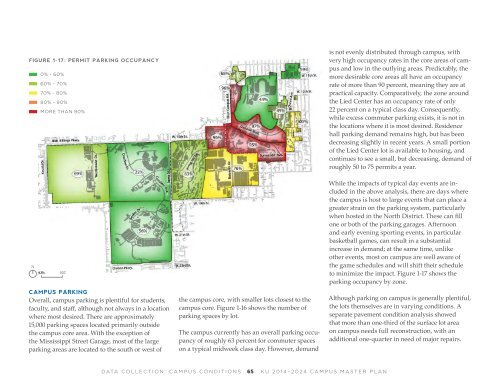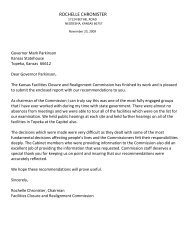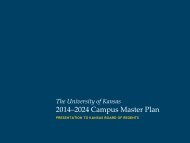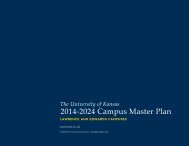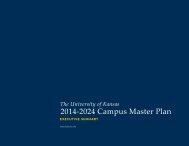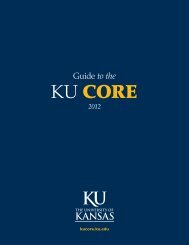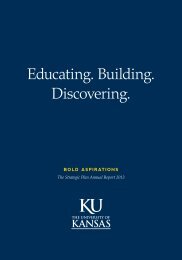KU_Chapter01_DataCollection_2014-06-10
KU_Chapter01_DataCollection_2014-06-10.pdf
KU_Chapter01_DataCollection_2014-06-10.pdf
- No tags were found...
Create successful ePaper yourself
Turn your PDF publications into a flip-book with our unique Google optimized e-Paper software.
FIGURE 1-17: PERMIT PARKING OCCUPANCY<br />
0% - 60%<br />
60% - 70%<br />
70% - 80%<br />
80% - 90%<br />
MORE THAN 90%<br />
is not evenly distributed through campus, with<br />
very high occupancy rates in the core areas of campus<br />
and low in the outlying areas. Predictably, the<br />
more desirable core areas all have an occupancy<br />
rate of more than 90 percent, meaning they are at<br />
practical capacity. Comparatively, the zone around<br />
the Lied Center has an occupancy rate of only<br />
22 percent on a typical class day. Consequently,<br />
while excess commuter parking exists, it is not in<br />
the locations where it is most desired. Residence<br />
hall parking demand remains high, but has been<br />
decreasing slightly in recent years. A small portion<br />
of the Lied Center lot is available to housing, and<br />
continues to see a small, but decreasing, demand of<br />
roughly 50 to 75 permits a year.<br />
N<br />
0 900’<br />
CAMPUS PARKING<br />
Overall, campus parking is plentiful for students,<br />
faculty, and staff, although not always in a location<br />
where most desired. There are approximately<br />
15,000 parking spaces located primarily outside<br />
the campus core area. With the exception of<br />
the Mississippi Street Garage, most of the large<br />
parking areas are located to the south or west of<br />
the campus core, with smaller lots closest to the<br />
campus core. Figure 1-16 shows the number of<br />
parking spaces by lot.<br />
The campus currently has an overall parking occupancy<br />
of roughly 63 percent for commuter spaces<br />
on a typical midweek class day. However, demand<br />
While the impacts of typical day events are included<br />
in the above analysis, there are days where<br />
the campus is host to large events that can place a<br />
greater strain on the parking system, particularly<br />
when hosted in the North District. These can fill<br />
one or both of the parking garages. Afternoon<br />
and early evening sporting events, in particular<br />
basketball games, can result in a substantial<br />
increase in demand; at the same time, unlike<br />
other events, most on campus are well aware of<br />
the game schedules and will shift their schedule<br />
to minimize the impact. Figure 1-17 shows the<br />
parking occupancy by zone.<br />
Although parking on campus is generally plentiful,<br />
the lots themselves are in varying conditions. A<br />
separate pavement condition analysis showed<br />
that more than one-third of the surface lot area<br />
on campus needs full reconstruction, with an<br />
additional one-quarter in need of major repairs.<br />
DATA COLLECTION: CAMPUS CONDITIONS<br />
65<br />
<strong>KU</strong> <strong>2014</strong>–2024 CAMPUS MASTER PLAN


